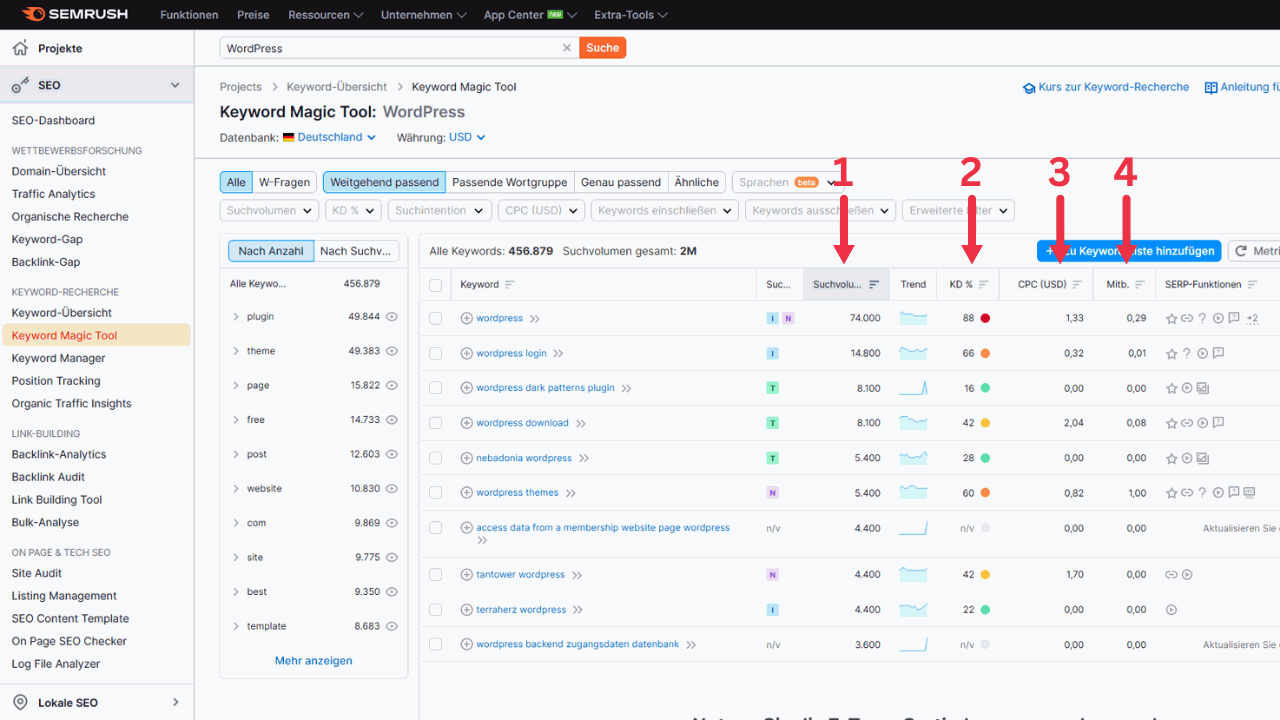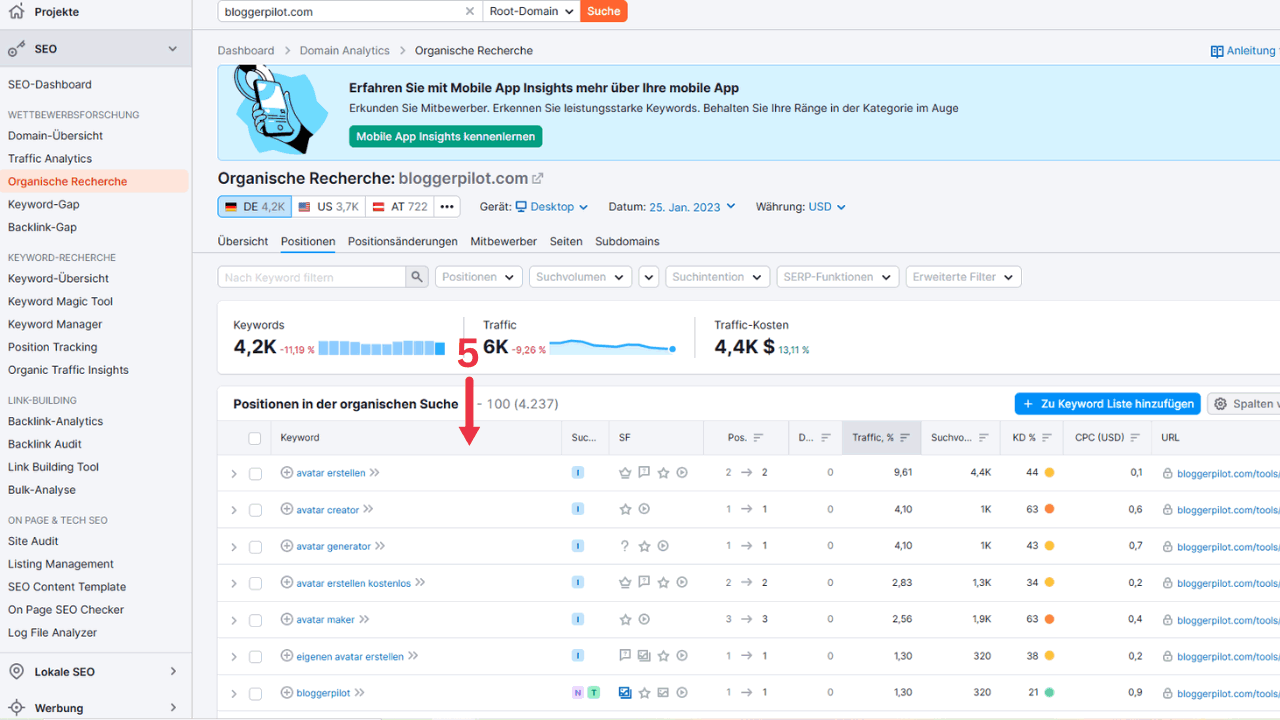Ultimate Guide For Your Semrush Keyword Research: How To Find Keywords In 4 Steps
The market is full of keyword research tools. Recently, I tested and compared ten popular keyword tools. The result: My personal test winner is Semrush! Here you can learn how to research terms with a high search volume using Semrush and get inspired by your competitors’ keyword set.
Semrush is a popular SEO tool that companies as well as agencies use to research keywords, analyze competitors and develop strategies for their SEO (search engine optimization). Through content optimization, users achieve a better ranking in Google search results.
Semrush’s keyword tool convinced me and even reached first place. Why? The selection of functions leaves nothing to be desired. Nevertheless, it is clearly arranged and thus suitable for agencies, companies as well as freelancers.
The functions for your Semrush keyword research at a glance
Semrush is an SEO all-rounder. In the following, I will introduce you to the most important functions for your Semrush keyword research in a quick run. If you’d rather start right away, jump directly to the instructions here.
1. Keyword overview: all metrics at a glance
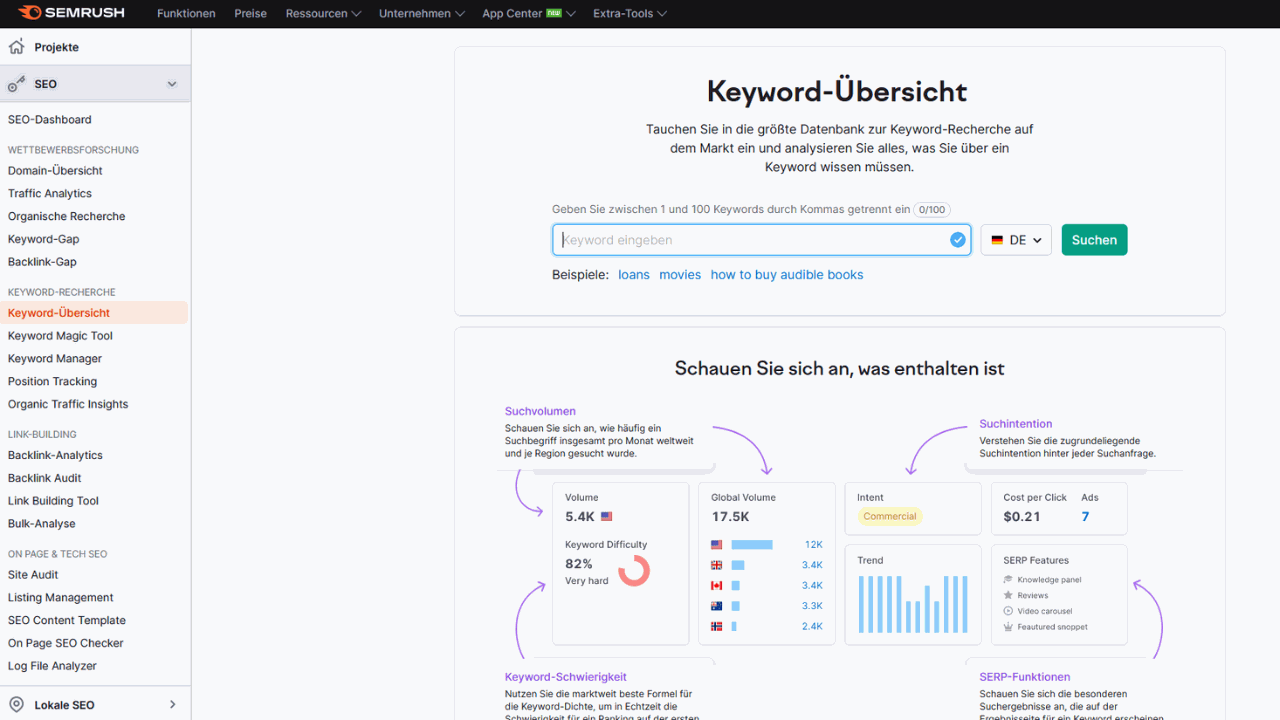
Do you want an overall impression of your keyword? Then you are exactly right here. The overview shows you all SEO-relevant metrics in concrete numbers and as a graphic – for example, using a diagram.
2. Keyword Magic Tool: perform extensive keyword research and collect keyword ideas

The Keyword Magic Tool is the heart of your Semrush keyword research. Here Semrush shows you all keyword suggestions including KPIs, which you can filter and sort as you wish.
3. Keyword Manager: Manage keywords in lists
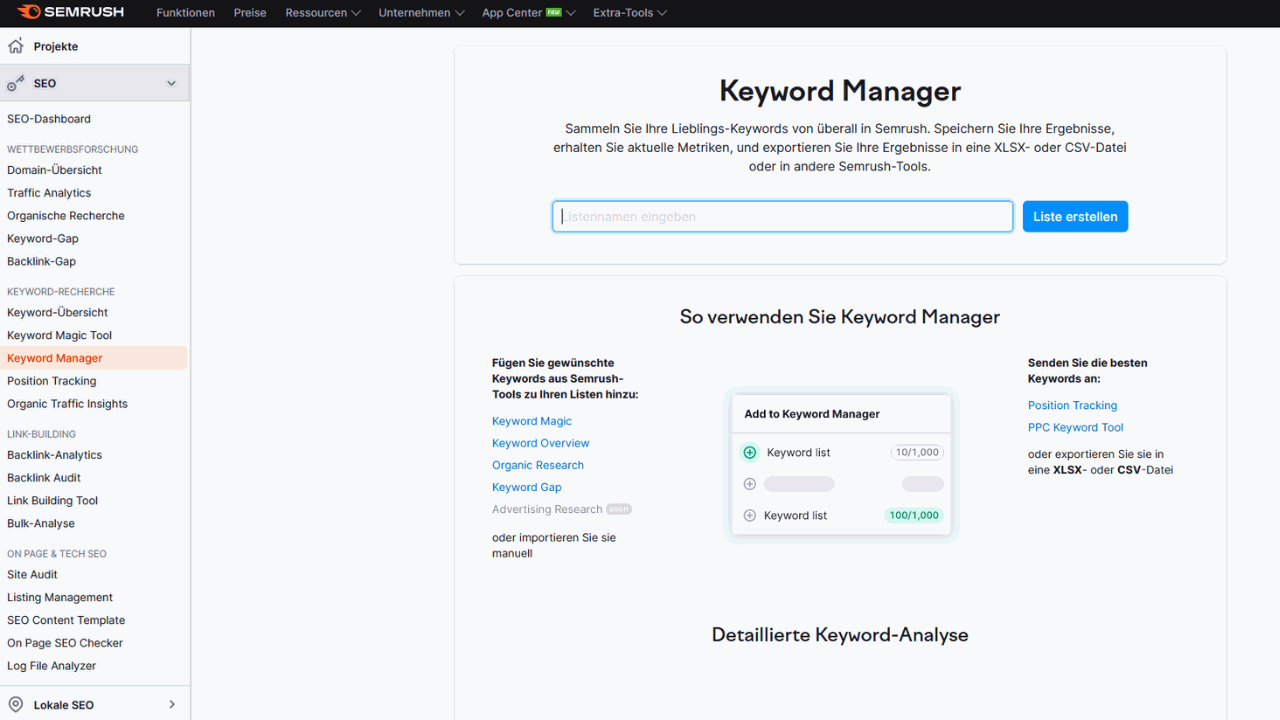
This is where it all comes together. The Keyword Manager:
- is the interface of the keyword research functions,
- stores researched keywords in lists,
- exports keyword data from Semrush,
- updates keyword metrics,
- distributes keywords to other keyword research functions and
- accesses the keyword database with 689 million DE keywords for analysis.
4. Position tracker: retrieve rankings, search volume and competitors

With the position tracker, you can monitor your own website as well as those of your competitors and thus discover new potential for yourself. Here, too, all metrics are analyzed and displayed to you.
5. Organic Traffic Insights: Increase data volume

This feature helps you discover keywords that don’t show up in Google Analytics and other tracking systems. Here you can link Semrush to other accounts – including Google Search Console. This allows you to gather even more data for your Semrush keyword research.
6. Keyword gap: research keywords through competitor analysis
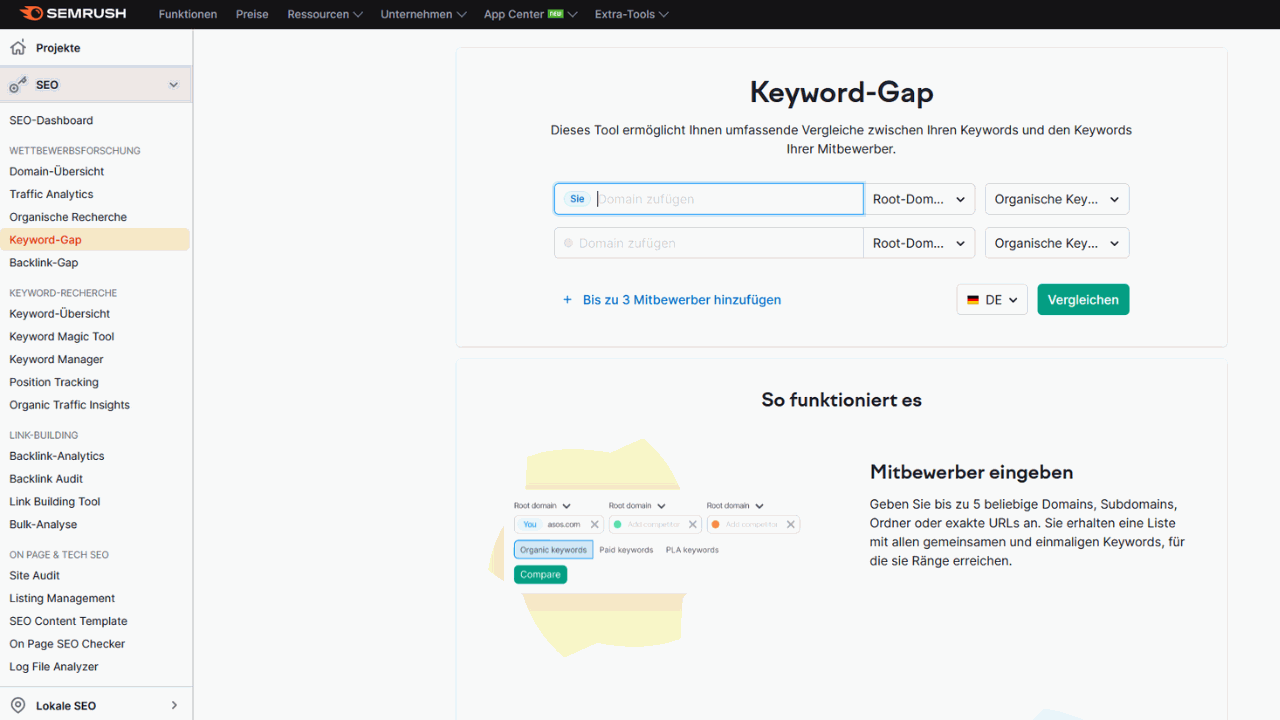
The Keyword-Gap function compares up to five domains at the same time. So you can compare the keywords of your website with the keywords of your four most important competitors. Semrush accesses the domain analysis database with 27.8 million DE domains (desktop) and 2.5 million DE domains (mobile) and 24.1 million DE keywords (desktop) and 3.6 million DE keywords (mobile).
7. Organic research: analyze organic keywords and rankings
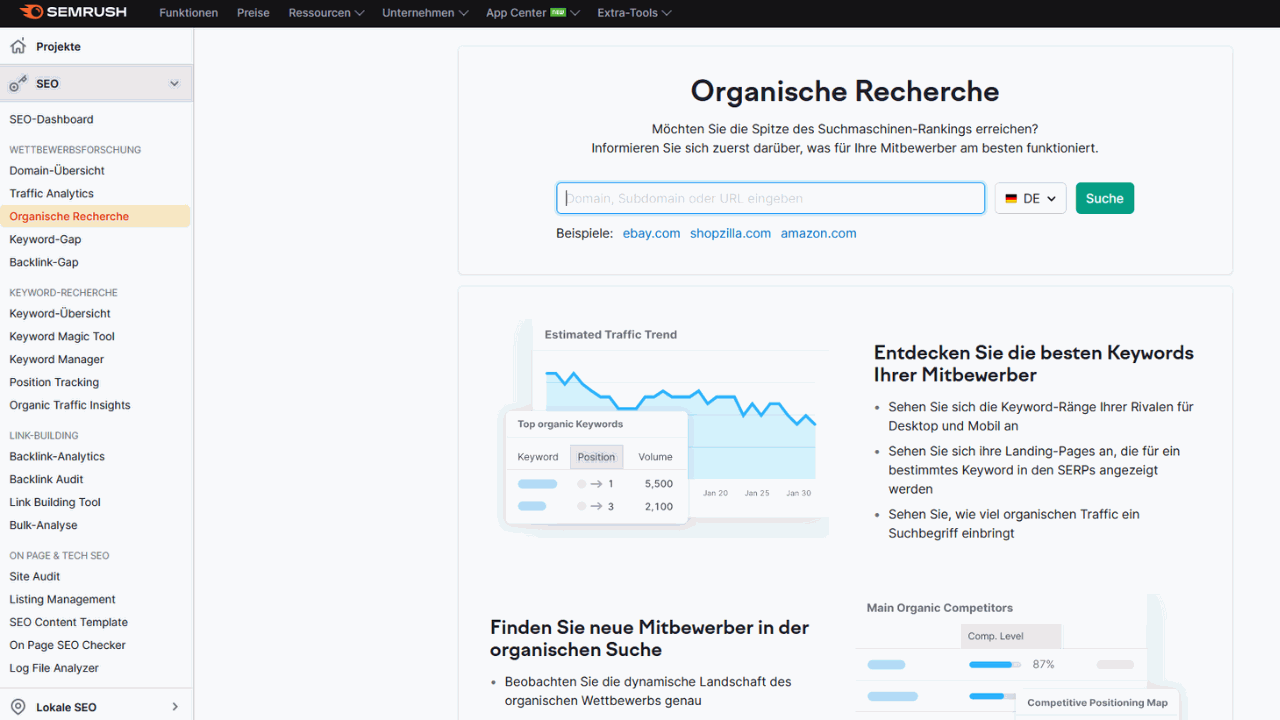
You want to perform a quick keyword research of (d)a domain? Then you should use the organic research of Semrush. Semrush accesses the domain analysis database with 27.8 million DE domains (desktop) or 2.5 million DE domains (mobile) and 24.1 million DE keywords (desktop) or 3.6 million DE keywords (mobile).
8. Content audit: systematic content audits perform

The content audit is not part of every single Semrush keyword research, but it should be performed regularly. A content audit provides information about how the individual articles of your blog rank.
Step-by-step guide: Keyword research with Semrush
First of all, you should think about the criteria you want to use to evaluate your researched keywords. I settle on these five metrics for my analysis:
- Search volume / Searchvolume (1)
- Keyword difficulty / Keyword Difficulty (2)
- Competition density / Competitors (3)
- Click costs / cost-per-click (4)
- your current rank in search results (5)
I can find out all this information using Semrush’s keyword tool. In this example, I will do two kinds of Semrush keyword research:
1.WordPress: I have already created a blog article for the seed keyword “wordpress”. I am aware that I am not ranking well enough for this yet. I am therefore analyzing my current ranking and my potential for improvement.
2.Content marketing: My analysis of the seed keyword “content marketing” should be the basis for a new article.
For both topics, I would like to determine one main keyword and two secondary keywords each. So that you can get to know my top 3 keyword research tools – i.e. Semrush, SurferSEO and the KWFinder – in direct comparison, my goal there will also be to determine one main keyword as well as two secondary keywords.
Step 1: Create a keyword list with Semrush
1. Preparatory measures
How much time the preparation will cost you probably depends on how experienced in sales and marketing you are. Semrush keyword research is part of your content marketing strategy. Thus, you can skip the first steps if you’ve already done them. Otherwise, it’s high time:
- Define USP (unique selling proposition): If you don’t want to optimize your own website, but offer this as a service, you should deal with this in depth. Before you even start with Semrush keyword research, you need to know what differentiates it from competitors.
- Conduct keyword brainstorming: The more keywords you can think of, the better. Collect terms that you, your customers, and teammates use in connection with the relevant topic.
- Review old keyword lists: If you’ve done keyword research before, you can go through them and incorporate appropriate keywords into your new list.
- Check PPC keyword lists: If you’ve already established PPC keywords, you should include them in your keyword research.
- Create personas for your website visitors: You should do your keyword optimization not just for a specific audience, but for a single persona.
2. Perform Semrush keyword research
You don’t have to go exactly the same way I did to get new keyword ideas in Semrush. Before we begin, here comes a little overview that tells you what tasks you can do in the course of your keyword research with which Semrush features:
- Finding good keywords, related keywords and W-questions: Keyword Magic Tool, Keyword Gap, organic research
- Find keywords of the competition: organic research
- Find opportunity keywords (of the competition): organic research and keyword gap
- Analyze metrics on keywords: Keyword Manager and Position Tracking
- Saving keywords: Keyword Manager
- Compare own rankings and those of competitors: Position Tracking
- Perform overall content audit: Content Audit
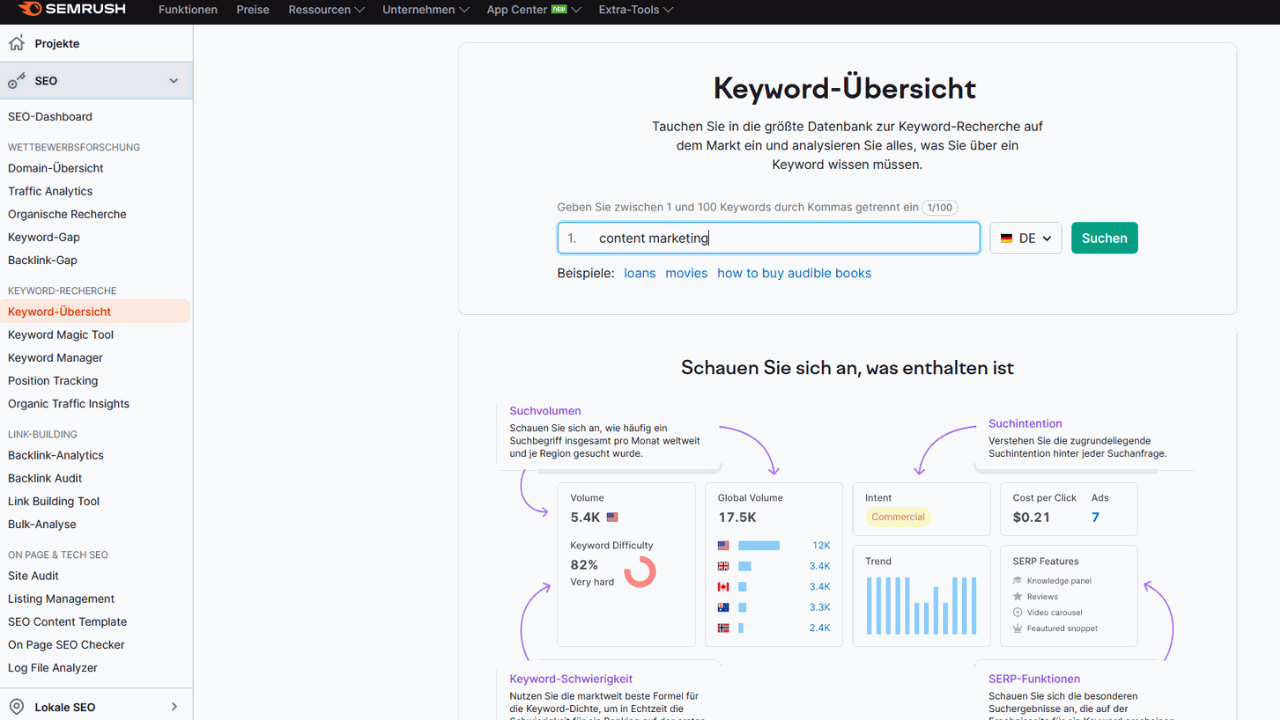
In the keyword overview, I enter my keyword “wordpress” or “content marketing” and select the country Germany. If your keyword brainstorming and old keyword lists have already yielded a lot of potential keywords, you can enter up to 100 keywords at a time in this field.
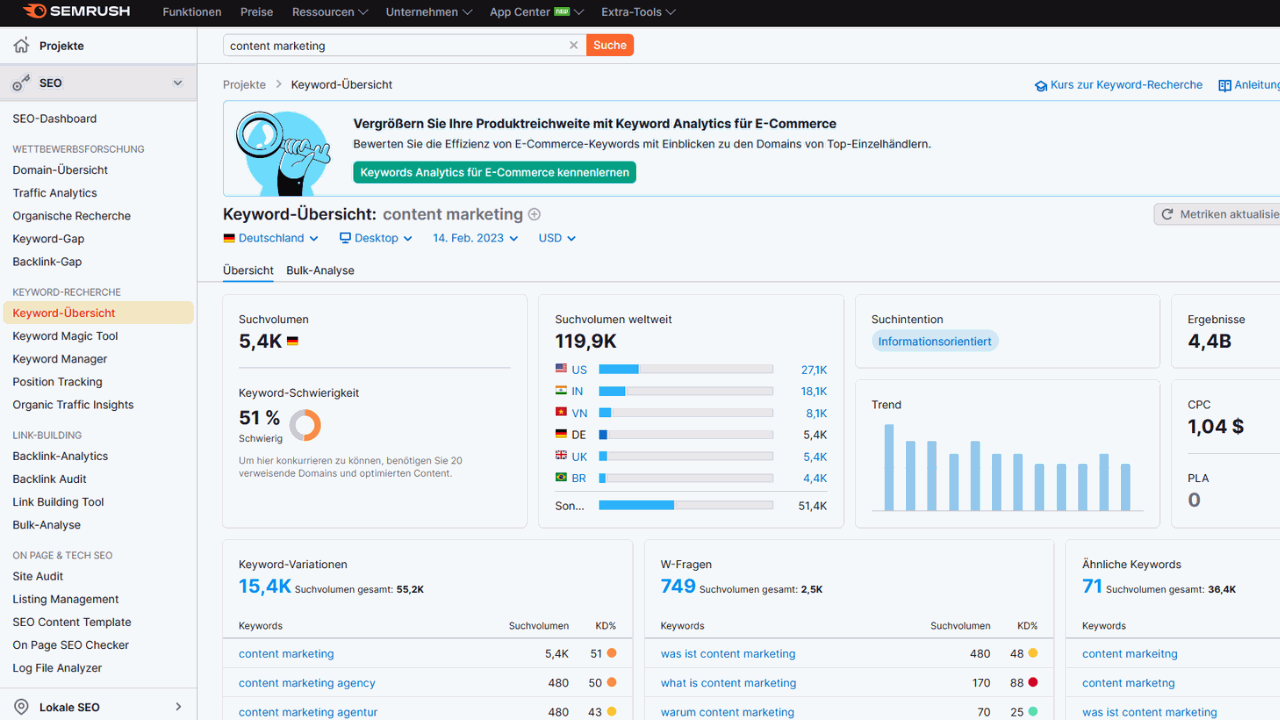
Now Semrush analyzes your keyword(s). The result of the analysis is clearly displayed. One thing stands out immediately: Both keywords are classified as difficult by Semrush. That means it will cost me a lot of work to rank for these terms. So I hope to find good alternatives for my main keywords.

Once I skim the overview, I switch to the Keyword Magic tool on the left to get deeper insights on the terms.
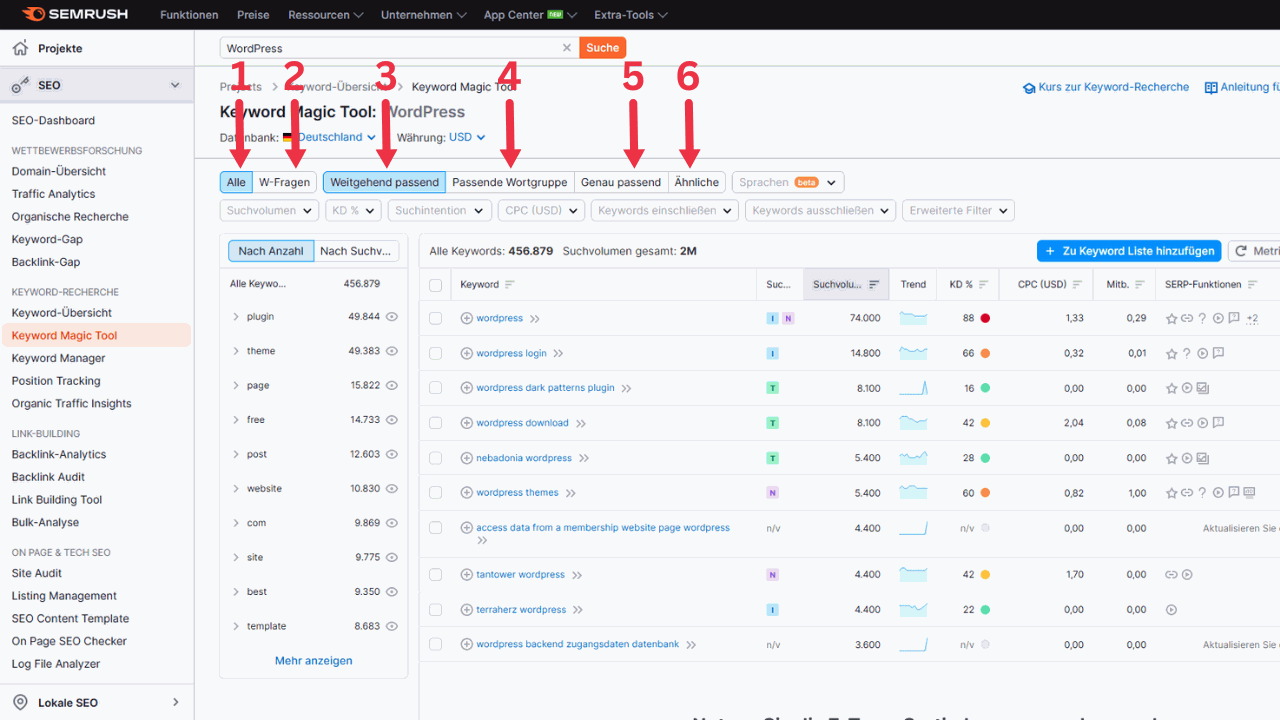
Here I’m shown lots of keyword ideas that match my search terms. I click through the tabs a bit and check which suggestions match the content of my article:
- All keyword suggestions (1)
- W-questions about the keyword (2)
- Largely matching terms (3)
- Matching word groups (4)
- Exactly matching terms (5)
- Similar search terms (6)
With further filters I can remove unsuitable suggestions:
- Search volume
- Keyword difficulty
- Search Intention
- Click cost(CPC)
- Include or exclude keywords
- Word count
- Competition density
- SERP features
- Results in the SERPs
- Languages
How much you should narrow down the results of your Semrush keyword research with filters depends primarily on the topic. If you are only shown a few keywords with low keyword difficulty, you should not be quite so strict at this point. Play a bit with the filter functions to collect as many (but good) keyword ideas as possible.
The keywords are automatically sorted by search volume (1). The keyword with the highest search volume is at the top. I first narrow down the selection via the filter function (2) into an achievable keyword difficulty: possible (30-49%).
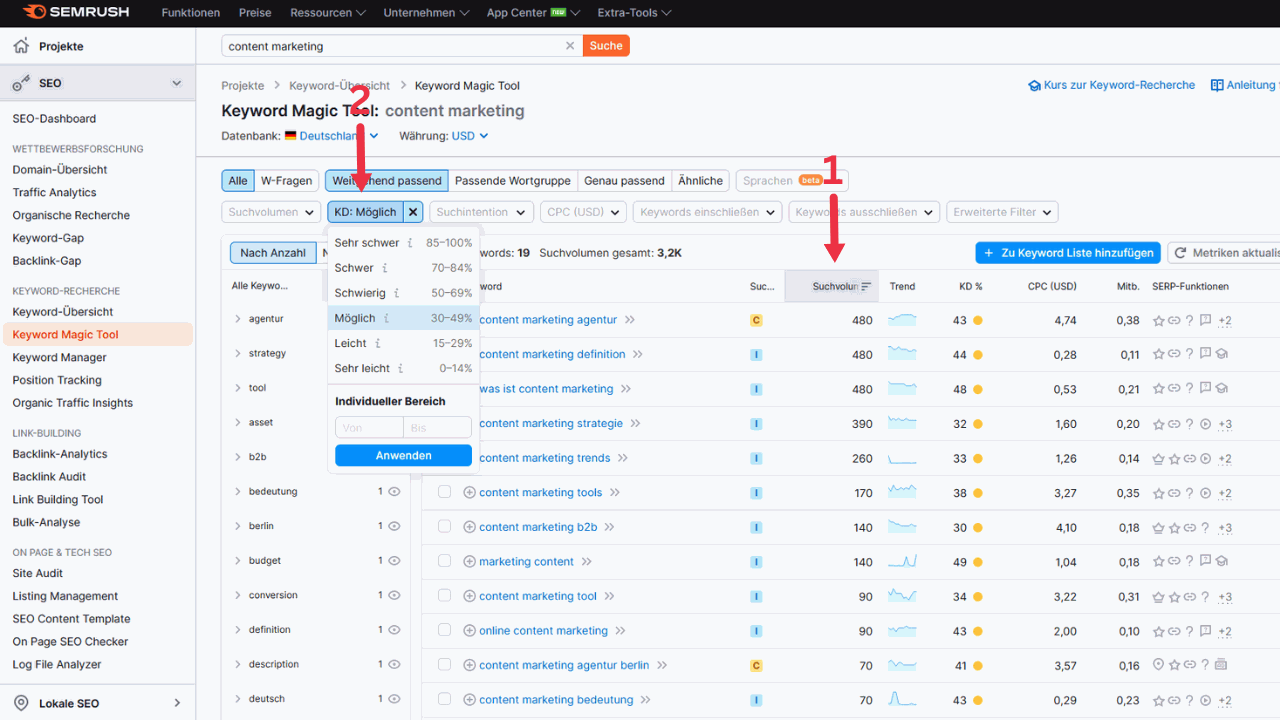
You can export records from Semrush as CSV and Excel files or add them to a keyword list. I skim the list and add all keywords to my keyword list (4), for which the interest of internet users remains more or less constant according to the metric Trends (3).

In the next step, I take a look at what my competitors are doing. Maybe I can pick up a keyword or two that I haven’t even thought of yet. Using the keyword gap function I can analyze similarities and differences between my website and competing domains.
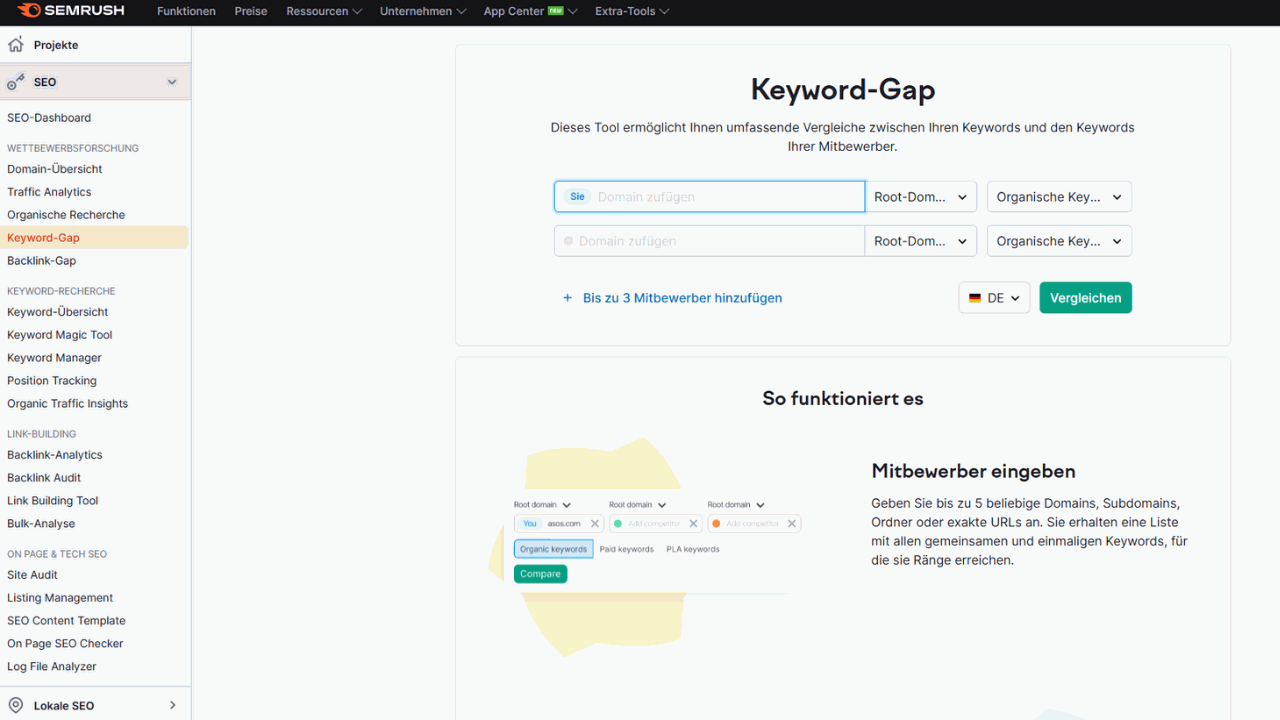
Here you enter at least one competitor including the corresponding country you want to compare with your website. I fill the data with four domains that I know about WordPress or content marketing.
These filters are available to you:
- URL type: root domain / exact URL / subdomain / subfolder (Semrush detects this itself and adjusts it automatically)
- Keyword type: Organic keywords / Paid keywords / PLA keywords
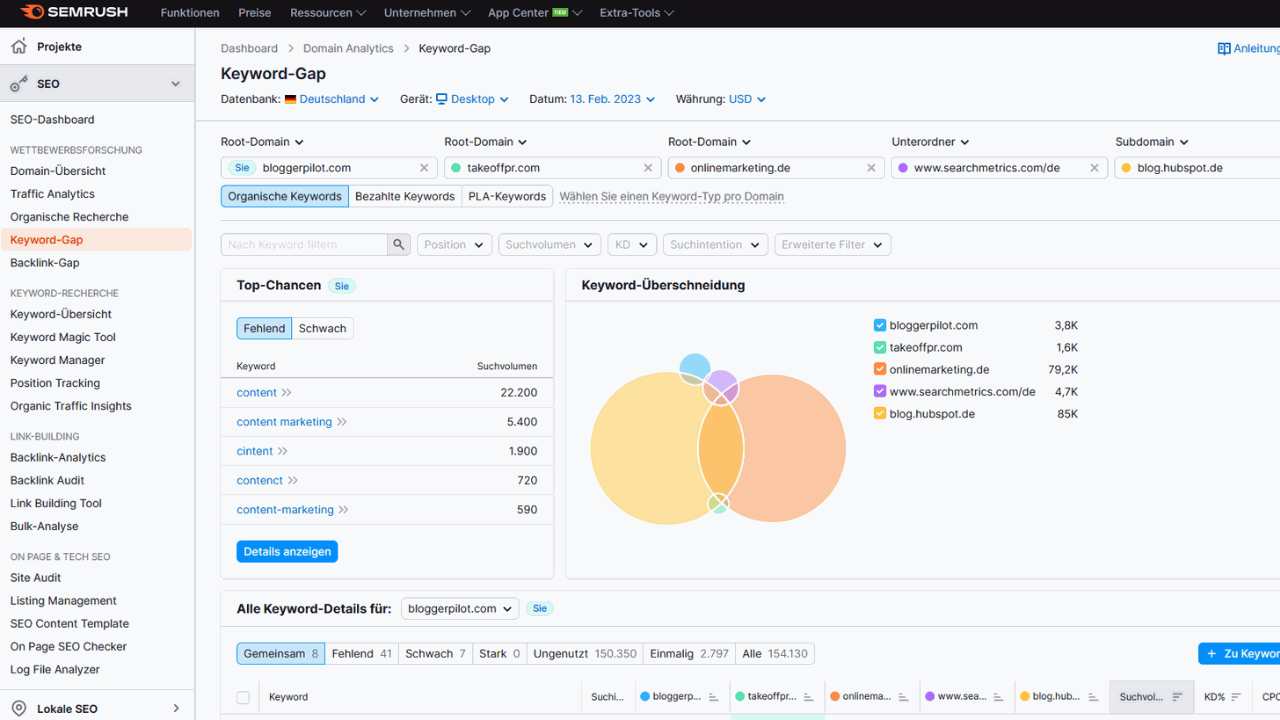
Here you can reapply all filters from the home page and e.g. switch from organic keywords to paid keywords, search for the top 20 or even for specific keywords.
With the many filters you can determine details like the start words of the results. I definitely look at what keywords my competitors are advertising for (1) and filter the keywords by “Unused”, as I assume they have done a thorough research beforehand. I also add keywords that match my article to my keyword list in the Keyword Manager using the plus symbol.
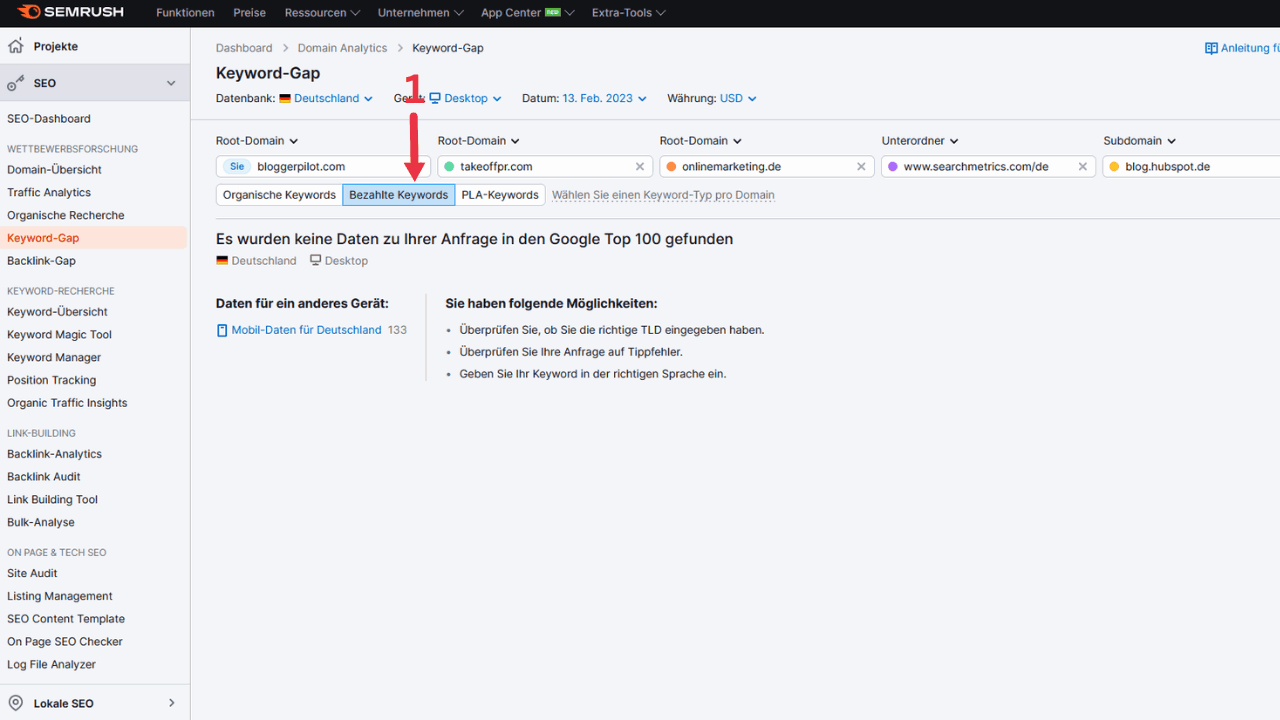
Before I take a closer look at my competitors for the keyword WordPress, I leave the domain of my already existing WordPress article and click on the Position tab (1). Here I can see on which position my analyzed article is currently ranking for certain keywords. It is definitely interesting to see that 100% of the generated traffic comes from the keyword phrase “What is WordPress” (2).
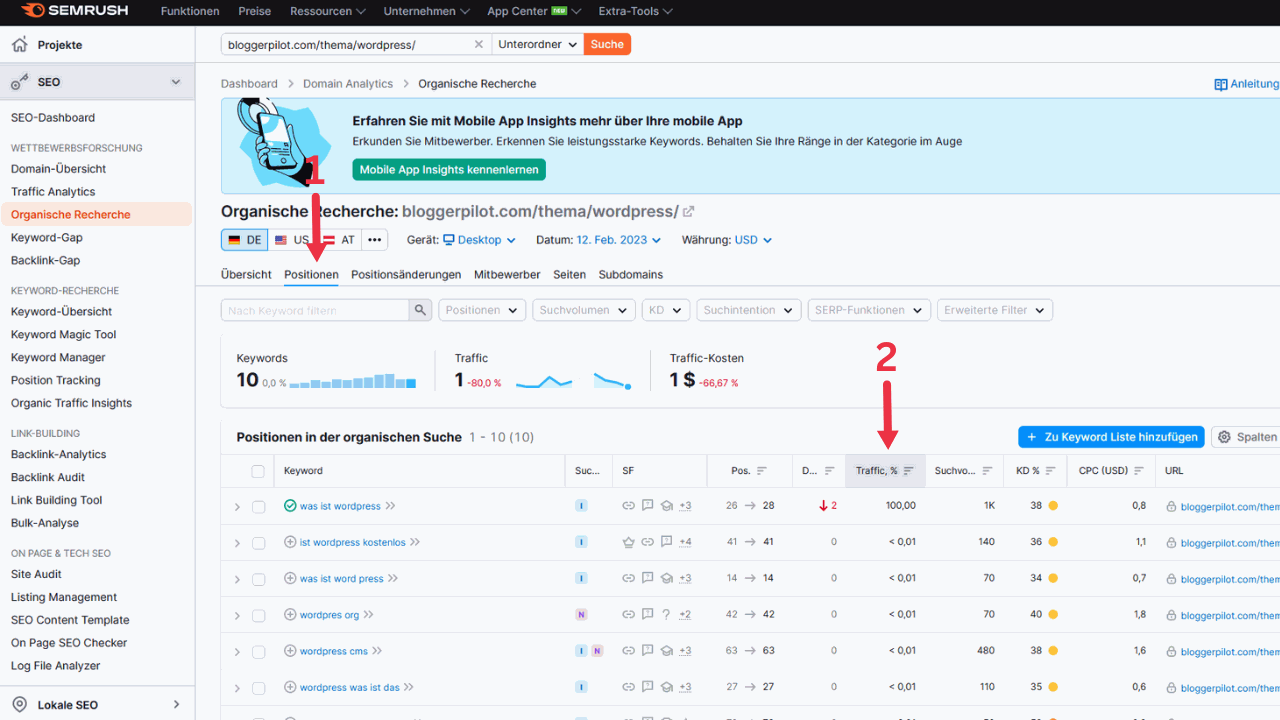
Let’s take a closer look at my competitors. For this, I enter “WordPress.org” as the domain to be analyzed. Here, all insights are provided to me. With the many filter functions, I can refine my selection, as in the entire Semrush SEO tool. To get new keyword ideas, I limit the keyword display to the top 20 keywords with a search volume of 101 to 1,000 and a keyword difficulty of 0 to 50 percent. I add matching keywords to the keyword manager as usual.
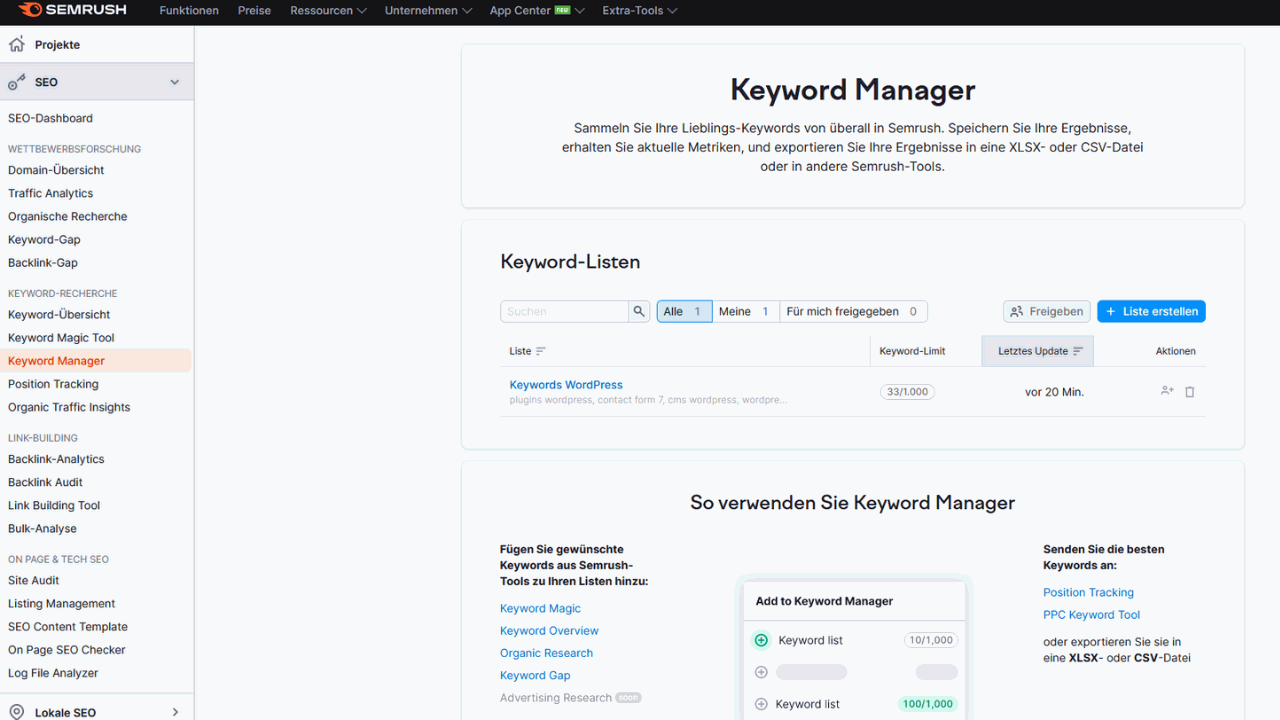
Here you can open your created keyword list. If you don’t have a keyword list when you start your Semrush keyword research, you can create a new list before you start the analysis. Clicking on the desired keyword list will open it.
You should get into the habit of always updating the metrics first (3) when you open a keyword list. In the keyword manager you will see all relevant information about the collected keywords:
- Search Intention (4)
- Search volume (5)
- Keyword difficulty (6)
- Click cost (7)
- Competition density (8)
- Click potential (9)
- Top competitors (10)
Now you can export the data from your Semrush keyword research (2) or send it to another Semrush tool (1). In this case, I choose to sort the data by search volume and export it as an Excel file.
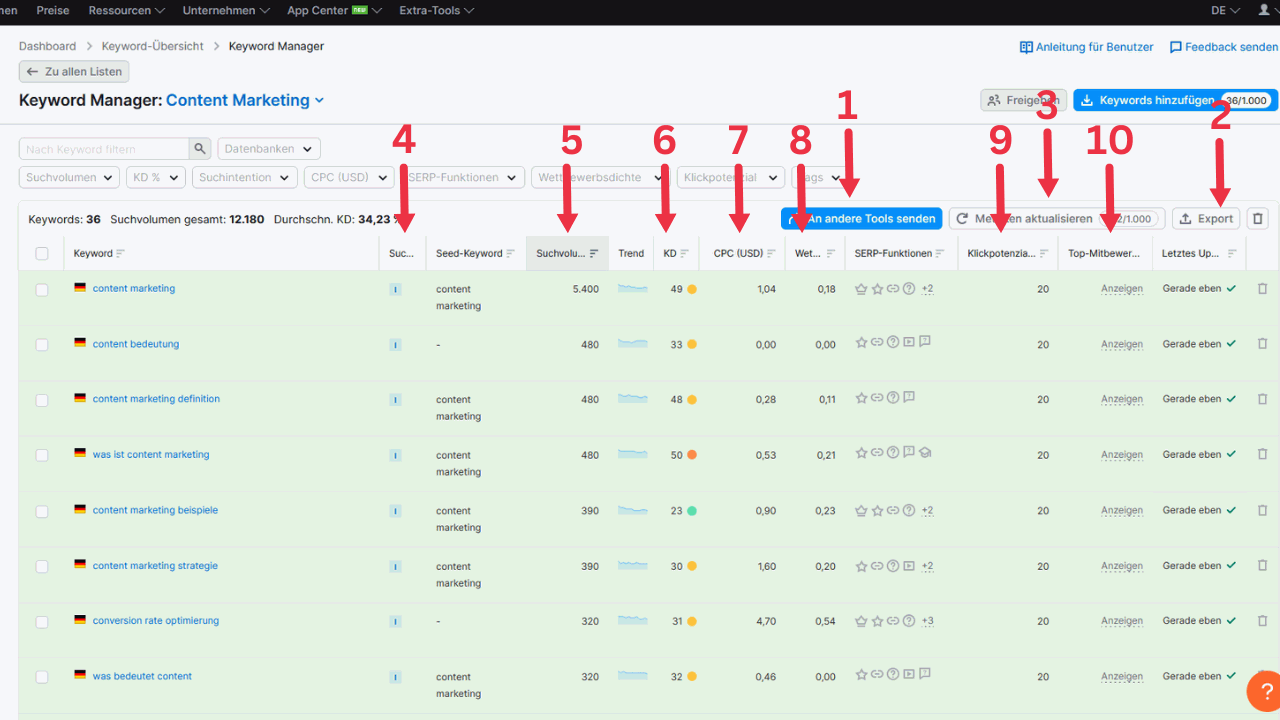
Step 2: Merge the keyword data with Semrush
The first step of your Semrush keyword research is done! Now you need to merge the researched data and clean up the Excel list.
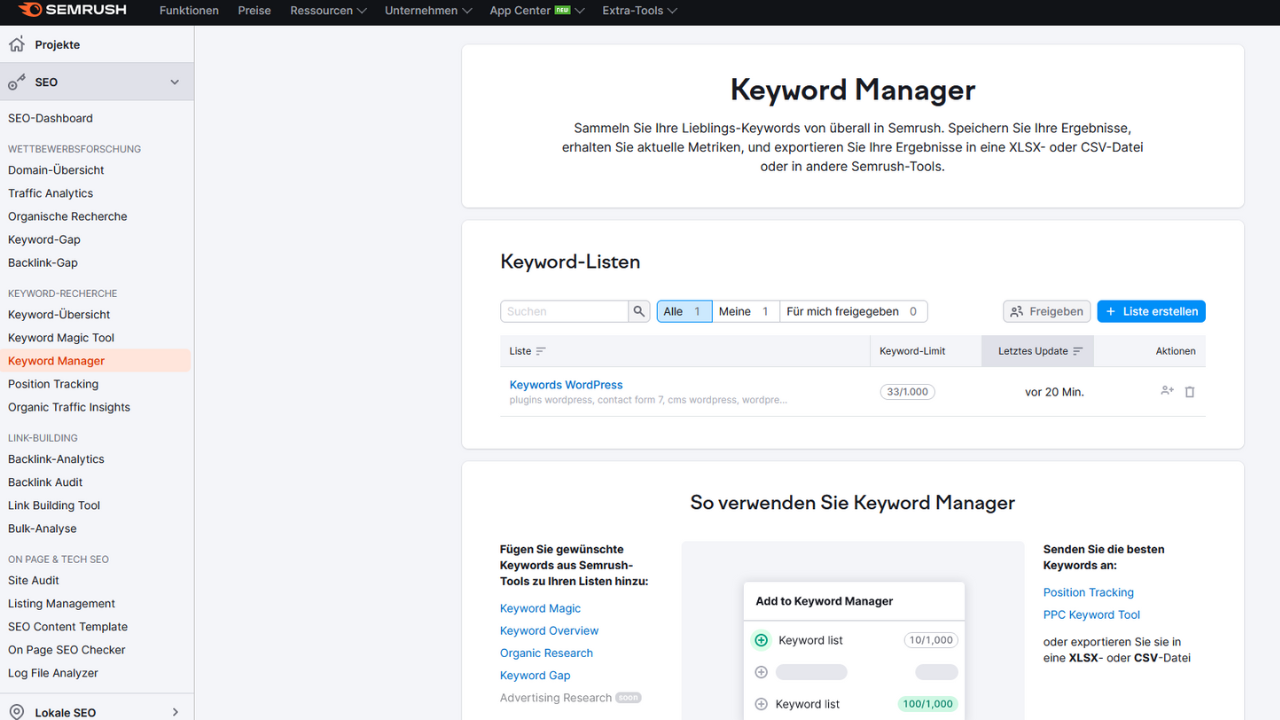
To do this, I first remove all the columns that I don’t need to evaluate the collected keywords. These are:
- Database
- Tags
- Number of Results
- SERP Features
- Trend
- Competitors
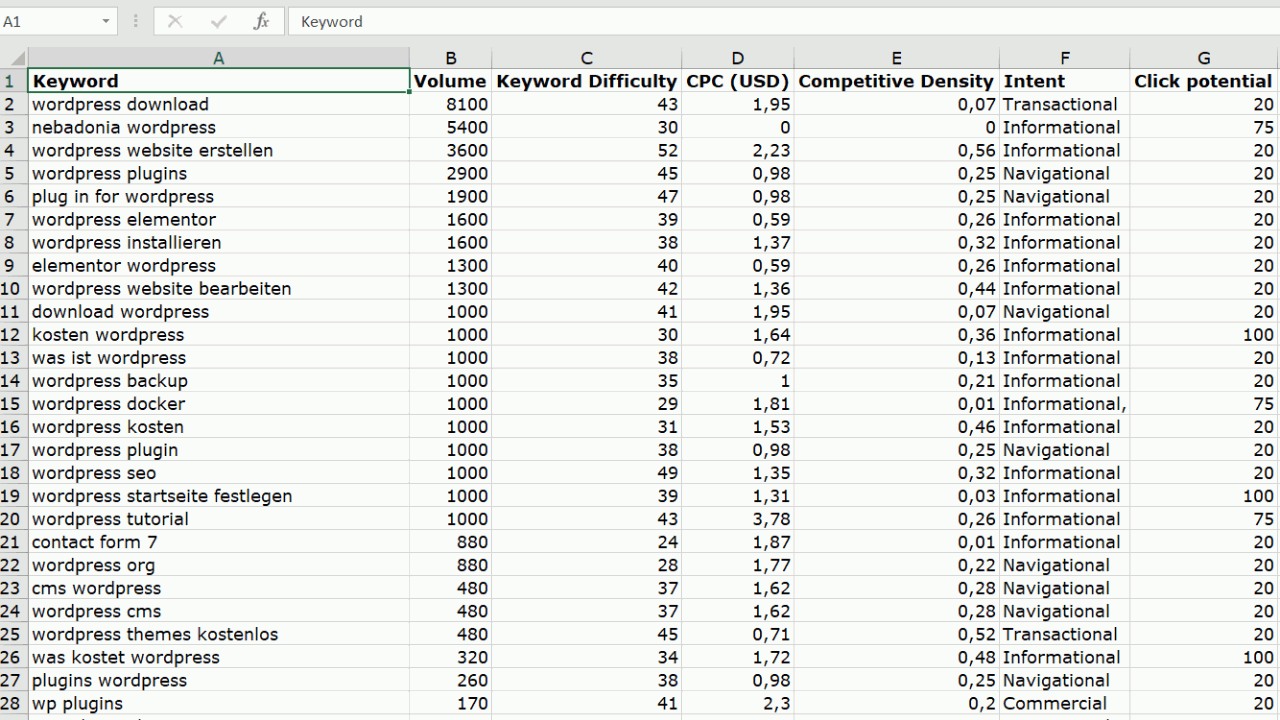
If you want to merge data from different SEO tools – for example, if you have researched additional keywords in Google Ads and KWFinder – remove the duplicates (Data > Data Tools > Remove Duplicates).
Step 3: Evaluate the keywords with Semrush
Now you can skim your cleaned up Semrush keyword research. This can sound like a lot of work, but trust me, it’s worth it. You can throw out a few keywords right away:
- Brand names
- Irrelevant keywords to users or your persona
- Misleading keywords based on search intent (inform vs. buy)
Step 4: Classify and prioritize the keywords with Semrush
Now I prioritize the terms from my Semrush keyword research:
- Prio 1: as high search volume as possible + as high click potential as possible
- Prio2 : high search volume + high keyword difficulty
- Prio 3: low search volume + low keyword difficulty
In my table, I have stored a rule (Conditional Formatting > New Rule) that should give me a first overview of the relevance of my keywords. It ensures that the values in my table are automatically formatted from green (optimal) to red (suboptimal). In the “Volume” column, this colors the highest values green and the lowest values red.

For my article on content marketing, I would determine the main keyword “content marketing” (Prio 1). Two of my secondary keywords would be “content meaning” (Prio 2) and “content marketing examples” (Prio 3).
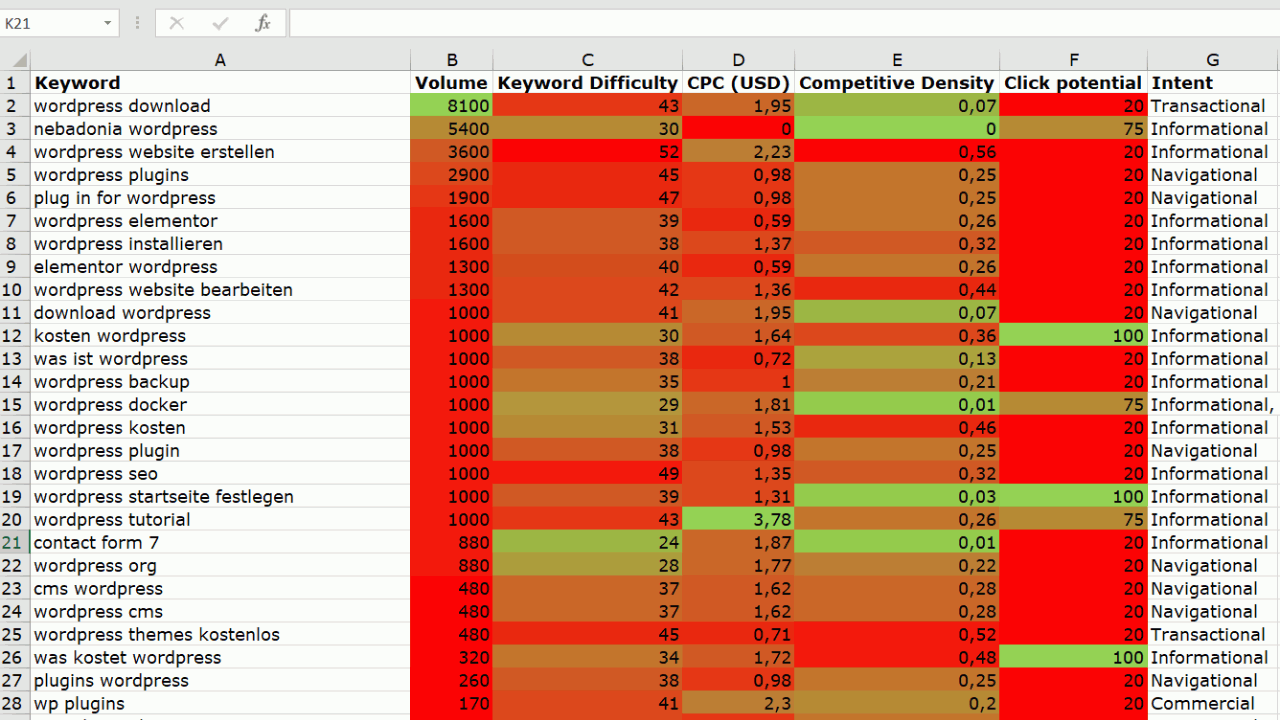
My decision, in this case, would fall on the main keyword “wordpress download” (Prio 1) due to the high search volume. Two secondary keywords that I would include in my keyword set are “create wordpress website” (prio 2) and “cost wordpress” (prio 3). Since the analysis showed that currently, 100% of my visitors arrive at my article via “what is wordpress”, this keyword phrase would remain in my keyword set.
Set only 1 main keyword and about 6 secondary keywords – both long-tail and short-tail keywords – for each article. Each keyword category has advantages and disadvantages. So I recommend you: choose keywords from all 3 categories for your set. Now you can write SEO text (search engine optimized text) in which you include the researched keywords in the appropriate places.
My expertise in keyword research
As an online marketing expert with 20 years of experience, I have extensive knowledge in all areas of digital marketing, including keyword research. Throughout my career, I have run numerous campaigns using various tools and strategies to identify the best keywords for each target audience. One of the most effective tools I have used in this process is Semrush. Through my accumulated knowledge and deep understanding of how Semrush works, I can provide valuable insights into keyword research and help build successful marketing campaigns.
Conclusion on Semrush keyword research
I can recommend Semrush keyword research to anyone who analyzes a lot of keywords and especially frequently keywords (if necessary with different keyword tools). Although Semrush is incredibly extensive, I quickly got to grips with it.
You are still not sure if Semrush keyword research is right for you? Then take a look at my tutorials on keyword research with SurferSEO, keyword research with KWFinder, and keyword research with Morningscore for comparison. You will see how different the processes are with the three keyword research tools and can assess which tool suits you best.

